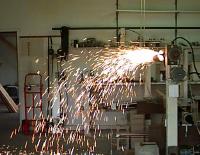|
The
Art Of
Motion Control
|
Plasma cutting -- "the poor man's laser:"
From the very first time I was able to get two stepper motors to work in concert to draw on an egg's surface, I realized that the exact same process could be used for laser cutting. Unfortunately, the cost of laser units with enough power to cut metal is stratospheric. By chance, a contractor friend who was over for dinner noticed a steel sculpture that my wife and I had recently bought and mentioned something like "must have used a plasma cutter." He explained its ability to cut any type of metal, using only compressed air and electricity-- and its relative affordability (small units start ~$500). Two years (and a few welding classes at Dunwoody Institute) later, I purchased this tool. I constructed a large-scale table dedicated to cutting in the summer of '94, and a year later, added the ability to cut cylinders.
Essentially, it works by creating an arc between the electrode in the torch head and the piece to be cut. Compressed air forces this arc through a tiny (~1mm) hole and produces a jet of plasma (~29,000 degrees F., too hot for atoms to hold on to their electrons). This narrow plasma jet instantly melts and blows clear through the metal plate. An awesome sight-- seen through a shade 12 welding lens!
The combined flat and cylinder cutting rig at "the Farm:"
Cutting flats:
Cutting cylinders:
Having the capability to cut metals under the control of computer aided design (CAD) allows for a wide range of sculptural possibilities (steel gallery).

